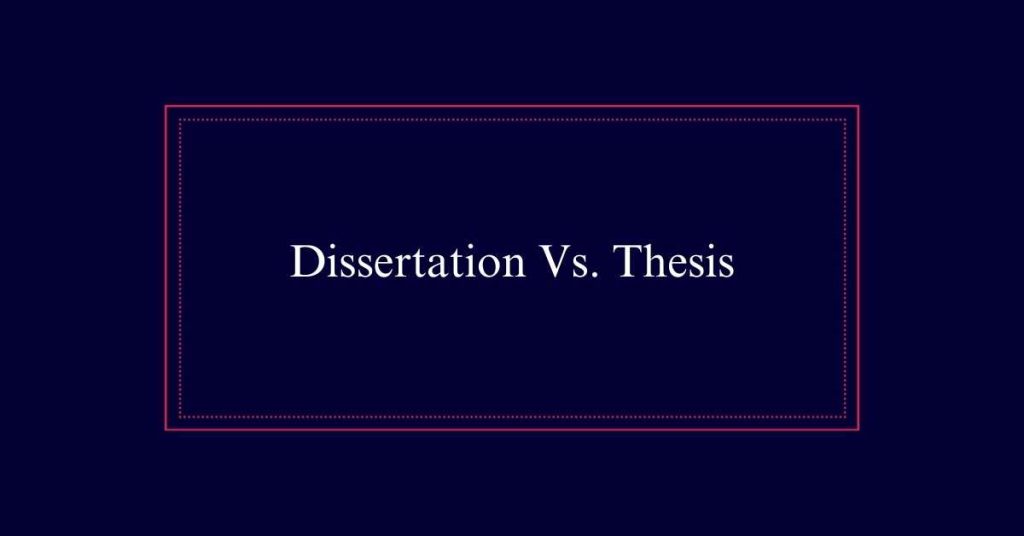Dissertation Vs. Thesis
A dissertation is required for a doctorate and involves original research aimed at contributing new knowledge. A thesis, in contrast, is for a master’s degree and tests the student’s understanding and analytical skills. Dissertations typically include empirical data collection and are longer, while theses review existing research. Both serve as critical milestones for graduation, but their scope and objectives vary.
Definitions and Context
In academic settings, a dissertation is typically a requirement for a doctorate degree, whereas a thesis is required for a masters degree. Both documents are lengthy research papers important for higher education. They serve as gatekeepers for graduation and degree eligibility.
Dissertations and theses differ in their scope and purpose. A dissertation involves original research and contributes new knowledge to the field. It is often book-length and may require a formal defense. On the other hand, a thesis may not always demand original research but tests a student’s understanding and analytical skills. It is shorter than a dissertation and serves as a culmination of a master’s program.
Dissertation Purpose
A dissertation aims to contribute new and original knowledge to its academic field. It represents a significant scholarly effort to advance understanding or propose new theories.
This process often involves identifying gaps in existing research and addressing them through thorough study. The research is typically empirical, gathering data through experiments, surveys, or other methods.
In nonempirical fields, it may involve extensive literature review and theoretical analysis. The final document must demonstrate the student’s ability to conduct independent research and present findings clearly.
A successful dissertation showcases the student’s expertise and readiness to join the academic community as a knowledgeable contributor. It culminates in a defense, where the student must justify their work before a panel of experts.
Thesis Purpose
While a dissertation aims to contribute new knowledge, a thesis focuses on demonstrating a student’s mastery of their subject matter. The purpose of a thesis is to show that the student has a deep understanding and can critically engage with their field of study.
It tests the student’s ability to conduct thorough research and analyze existing literature. The thesis serves as a capstone project, bringing together the knowledge and skills gained during the coursework. It may involve some original research, but its primary goal is to synthesize existing information and present it coherently.

Research Requirements
Understanding the research requirements is essential for both dissertations and theses. Dissertations demand original research with new discoveries in the field. This often involves collecting and analyzing empirical data, particularly in scientific disciplines.
Nonempirical research methods, such as theoretical analysis, are more common in the humanities. In contrast, a thesis typically requires a thorough review of existing research rather than original findings. It tests a student’s ability to synthesize and analyze existing knowledge.
Both require a significant amount of work, but the depth and originality of research distinguish a dissertation from a thesis. Meeting these research requirements is crucial for the successful completion of either academic project, paving the way for graduation and degree conferral.
Dissertation Structure
After meeting the rigorous research requirements, structuring the dissertation effectively is the next step to guarantee clarity and coherence.
A well-organized dissertation typically includes several key components. It starts with an introduction that outlines the research question and objectives.
The literature review follows, summarizing relevant research and identifying gaps. The methodology section details the research design, data collection, and analysis methods.
Results present the findings in a clear and logical manner. The discussion interprets these findings, linking them back to the research question and existing literature.
Thesis Structure
A well-structured thesis is essential to effectively communicate the research and findings of a master’s or bachelor’s degree project. The structure guarantees clarity and coherence in presenting the research. Typically, a thesis includes several key sections:
- Introduction: This section outlines the research question, objectives, and significance of the study. It sets the stage for the entire thesis.
- Literature Review: Here, existing research related to the topic is reviewed. This section identifies gaps that the current study aims to fill.
- Methodology: This part details the research methods used, including data collection and analysis techniques. It ensures transparency and reproducibility.
Oral Defense
The oral defense is an essential part of completing a dissertation or thesis, requiring students to present and defend their research before a panel of experts. This process allows the student to demonstrate their understanding and the significance of their work. The panel poses questions to evaluate the depth of the research and the student’s ability to articulate their findings.
Here is a comparison of dissertation and thesis defenses:
| Aspect | Dissertation Defense | Thesis Defense |
|---|---|---|
| Degree Level | Doctorate | Master’s/Bachelor’s |
| Original Research | Required | Not always required |
| Panel Composition | Subject Experts | Faculty Members |
| Outcome | Graduation Decision | Program Completion |
American Vs. British Terms
Understanding the distinction between dissertation and thesis becomes more significant when considering American versus British terminology. In the United States, a dissertation is required to obtain a doctorate degree, while a thesis is for a master’s degree.
However, in the United Kingdom, these terms are used differently. A thesis is written for a doctorate degree, and a dissertation is prepared for a master’s degree. This variation can lead to confusion for students and educators alike.
To clarify:
- American English: Dissertation for doctorate, thesis for master’s.
- British English: Thesis for doctorate, dissertation for master’s.
- Clarification Needed: Always check the specific definitions at your institution.
These distinctions are important for academic clarity and proper document preparation.
Degree Level Differences
Understanding the differences between degree levels is essential for grasping the distinct requirements of dissertations and theses. Dissertations are typically needed for doctorate degrees, while theses are required for masters degrees. This difference stems from the depth and originality of research expected at each academic level. Dissertations demand original contributions to the field, often involving empirical research. Theses, on the other hand, focus more on demonstrating a student’s understanding and analytical skills.
| Degree Level | Dissertation | Thesis |
|---|---|---|
| Doctorate | Required | Not Required |
| Masters | Not Required | Required |
| Research Type | Original | Analytical |
| Length | Book-length | Long Paper |
This distinction helps define the scope and complexity of the work involved.
Institutional Variations
Institutional variations play a significant role in defining and differentiating dissertations and theses. These differences can impact the structure, length, and requirements for these academic documents. Some universities may have unique definitions and expectations.
- Degree Level: Certain institutions may require a dissertation for both doctoral and master’s programs, while others reserve dissertations solely for doctoral studies.
- Research Requirements: Some universities may necessitate original research for both theses and dissertations, while others may only require it for dissertations.
- Submission and Defense: The process of submission and defense can differ. Some institutions might mandate an oral defense for both, while others may only require it for dissertations.







